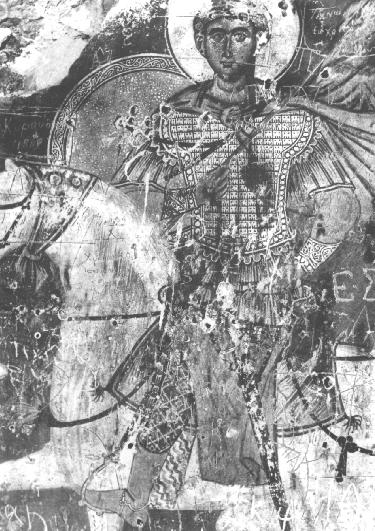Create an Amazon Business Account

Create an Amazon Business Account
St. Demetrios, Fresco, Monastery of the Forty Martyrs, Lakedaemona, Byzantine Morea, Greece, 1304/5 AD.

Fig. 14. Lakedaemona, monastery of the Forty Martyrs, St. Demetrios
photo: after N. Drandakes, [1992]: (fig. 19)
Painters in the Byzantine Morea commonly represented equestrian saints with their spears held aloft.
In the thirteenth century narthex decoration of Vrontamas, portraits of Niketas and George, with spears uplifted, occupy the east wall (Fig. 13).
The saints, who confront each other, were painted by two artists who employed different styles for the faces, although the horses and military costumes may have been painted by a single hand.
Niketas is rendered in Byzantine fashion; his face is modeled, and skin tones are layered on an ochre base.
The style of the second saint, George, is flatter and resembles the linear treatment of the equestrian St. Sergios on the two Crusader icons at Mount Sinai dated to the late thirteenth century
(Figs. 4, 5).82
The faces possess a limner quality; they are flattened and highlighted by thick lines.
The eyes of the saints are articulated in a similar fashion; eyebrows arch from the bridge of the nose to the extended crease of the outer corner of the lid.
The hollow of the neck on all the figures is emphasized by a shaded “V.”
Like the Sinai figures, the Vrontamas George rides on a white horse; his spear is held across his chest in his right hand; a scabbard is attached to his saddle in place of a quiver; his weight is supported by triangular stirrups; and prick-spurs encircle his ankle.
The saint wears the short mail hauberk and the long surcoat of the cavalryman.83
These common elements suggest that the Vrontamas painter was aware of certain features that have been identified with military imagery in the Crusader East.
Once the parade format was adopted in the Morea, it was repeated in a number of smaller churches, some of which may have been decorated by a common workshop.
Close to Vrontamas, in St. Nicholas near Geraki (1280–1300), a portrait of St. Demetrios decorates the recessed arch on the north wall.84
Although the image is damaged, the main lines of the representation are clear: Demetrios carries his spear in his right hand, and his roan horse rears on its hind legs in anticipation of imminent confrontation.
Another example of a military saint in parade format is found in the nearby monastery of the Forty Martyrs near Sparta (Fig. 14).85
The wall paintings of the cave church are dated by one inscription to 1304/5; a second inscription provides the name of the painter (historiographos) as Constantine Manasses.
In this church, St. Demetrios sits astride a white horse with his spear held across his chest.
The saddle has a raised cantle and pommel, features found on the Sinai portraits of Sergios and the images of St. George at Nauplion and St. John Chrysostom, Geraki.
In Demetrios’ portrait, the saint wears a lamellar hauberk and a long surcoat over ornately patterned leggings.
The painter has added an unusual element to the composition — a scarf tied around the horse’s head and knotted below its neck.86
The depiction of equestrian saints in parade format is a departure from the serpent-spearing riders of earlier periods.
The courtly display of intricate weaponry and equestrian prowess falls closer to representations that have been termed Crusader.
82 Drandakes, pl. 86b. Drandakes compares the representation of St. George to the Sinai icon of Sergios and Bacchos. The portrait of St. Niketas is not illustrated in his article.
83 For the military costume, see D. C. Nicolle, Arms and Armour of the Crusading Era, 1050–1350 (New York, 1988);
A. Hoffmeyer, “Military Equipment in the Byzantine Manuscript of Scylitzes in Biblioteca Nacional in Madrid,” Gladius 5 (1966): 8–160.
84 A. Gkiaoure (Bakourou), (1977): 105–6, pl. 39. Bakourou relates the portrait to the Vrontamas saints.
85 N. Drandakes, (1992): 125, fig. 19. In his analysis of the portrait, Drandakes observes that the work is reminiscent of a portable icon.
Yet another saint in parade format is found in the church of St. Niketas in Karavas in the Mani, dated 1270–90. See Gkioles, 172–73, pl. 3a.
86 For a similar detail, a red scarf on a white horse, see the church of the Virgin at Rustika, Crete, dated 1381–82 (M. Bissinger, Kreta: ByzantinischeWandmalerei [Munich, 1995], fig. 150).
In this church, it is George’s horse who wears the ornamental scarf. In the church of St. Paraskeve, in St. Andreas (Epidauros Limera), dated to the second quarter of the 15th century, Demetrios’ horse has a scarf around the neck. See N. Drandakes, S. Kalopissi, and M. Panayotidi, (1983): pl. 170b.
Source: pp. 276-277, Sharon E. J. Gerstel "Art and Identity in the Medieval Morea"
in The Crusades from the Perspective of Byzantium and the Muslim World edited by Angeliki E. Laiou and Roy Parviz Mottahedeh
See also Icon of Saint Sergius equiped as a Turcopole, St Catherine’s Monastery, Sinai, late 13th century
Other Byzantine Illustrations of Costume & Soldiers
Other 14th Century Illustrations of Costume & Soldiers


